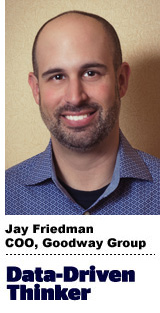 “Data-Driven Thinking” is written by members of the media community and contains fresh ideas on the digital revolution in media.
“Data-Driven Thinking” is written by members of the media community and contains fresh ideas on the digital revolution in media.
Today’s column is written by Jay Friedman, chief operating officer at Goodway Group.
Already, 2018 is shaping up to be a very interesting year.
Our industry is getting close to making real progress on some of the core issues with solutions that have been stagnant.
Issues such as transparency, fraud and nascent mobile adoption will be addressed in a meaningful way. Other issues like consolidation and attribution, or lack thereof, will continue to permeate.
Here’s a breakdown of what I expect to happen this year.
The Start Of A Transparency Breakthrough
With first-price auctions becoming more prevalent and CPMs rising, not to mention increased vigilance around fraud, 2018 is the year we’ll see real progress in our ability to follow the money.
How exactly will this happen? It probably won’t be blockchain, but innovations and advancements in payment tracking will enable the first real breakthrough in end-to-end transparency. This progress might help us to avoid scenarios such as the following: A DSP says $100,000 is spent with Publisher A. When contacted, Publisher A only finds $1,532 was spent. Two months later and after 100 collective hours to track this information, the buyer realizes the actual amount was $73,394, with third-party ad tech fees considered.
However, 2018 will also likely bring about the Great Transparency Disappointment.
Financial transparency is the No. 1 issue for marketers. This issue has crossed the line from being a pain point to being an emotionally charged crusade led by folks like Marc Pritchard of P&G. It’s easy to imagine CMOs being pumped at the idea of achieving full transparency in their marketing. But it’s also just as easy to imagine the major let-down they’ll experience when they realize smart digital marketing simply costs more than they’re willing to pay.
They might also realize that the more they apply downward pressure on costs and margins, the worse their results will be, and that there are technologies – and let’s not forget the people – that deliver a greater return than they cost.
Fraud Achieves Retail Shrinkage Status
Fraud remains a major issue. Just recently another major fraud operation was uncovered. But domain spoofing is improving with Ads.txt adoption, and overall suspiciousness is declining with more, better ways to buy inventory directly and programmatically.
Of course, there is no eliminating fraud altogether. It is too lucrative, can occur across international borders and has a low prosecution rate. Like retail shoplifting, to which retailers have become accustomed and use shrinkage projections, we will protect against fraud and fight it vigilantly, and I would expect that next year, smaller amounts will be lost to fraud overall.
Programmatic And Direct Site Costs Continue Convergence; Mobile Rises Sharply
The CPMs charged by sites in the late ’90s and early ’00s were inflated and unsupported. When this market achieved some liquidity, prices tanked. We now know supply isn’t unlimited. Programmatic CPMs have climbed and will continue climbing with first-price auction implementation, and eventually we should see programmatic and manual IO CPMs meet somewhere in the middle of where each was 10 years ago.
One area where we will continue to see huge rises in ad inventory prices is in mobile. Since mobile is still an emerging and underused category, prices have not yet caught up to their potential and have a long way to climb. The increasing popularity of planning for cross-device and people-based executions also means that marketers will continue to fuel demand for quality mobile inventory.
So, while 2018 will likely mean modest gains for desktop programmatic pricing, mobile ads will become increasingly expensive as marketers tap into quality inventory.
Attribution Woes Continue
They say the average tenure of a CMO is 18 months. It’s a hot-seat job because it’s highly visible to everyone and one of the hardest to measure for success. Yet almost every major brand and agency I speak with still judges the bulk of their campaigns on the last ad seen or worse, last-click.
Any CMOs allowing this to happen by not digging deeper into their data are wasting huge chunks of their budget – potentially wasting more here than on fraud or non-transparency. Yet I predict that our industry makes no progress on this issue in 2018 because we’re distracted by other issues that seem easier to solve.
Still WAY Too Many Supply-Side Platforms (SSPs)
How many SSPs do we really need? At most, five SSPs in display, mobile, video and native? That’s 20, assuming no crossover, which is unrealistic. Realistically, we would be amply served with fewer than 10 total SSPs spanning all channels.
Yet, as we close out 2017, I don’t expect to see significant consolidation in this space. 2019 may be different, though, as the holding companies and marketers ramp up their direct buying capabilities and shut out undifferentiated supply sources. I sure hope I’m wrong on this one and that the pace accelerates.
Consolidation and attribution aside, we’re poised to make some big leaps in programmatic next year. That’s reassuring. It has only taken us 10 years to get to this point.
In 50 years, the industry will look back at this time in amazement. Programmatic will be considered an incredible achievement, the automatic transmission or central air conditioning of advertising. Until that point, there are definitely bumps in the road, but so long as marketers continue to focus on achieving the greatest lift in performance for the least amount of money, programmatic’s true potential may soon be within reach.
Follow Jay Friedman (@jaymfriedman) and AdExchanger (@adexchanger) on Twitter.
This post was syndicated from Ad Exchanger.

More Stories
Everyone must go Tourism NZ campaign is no 100% Pure… But this might just work
Waka Kotahi tackles drug driving with FCB and MBM
Unbound joins HubSpot for elite client data